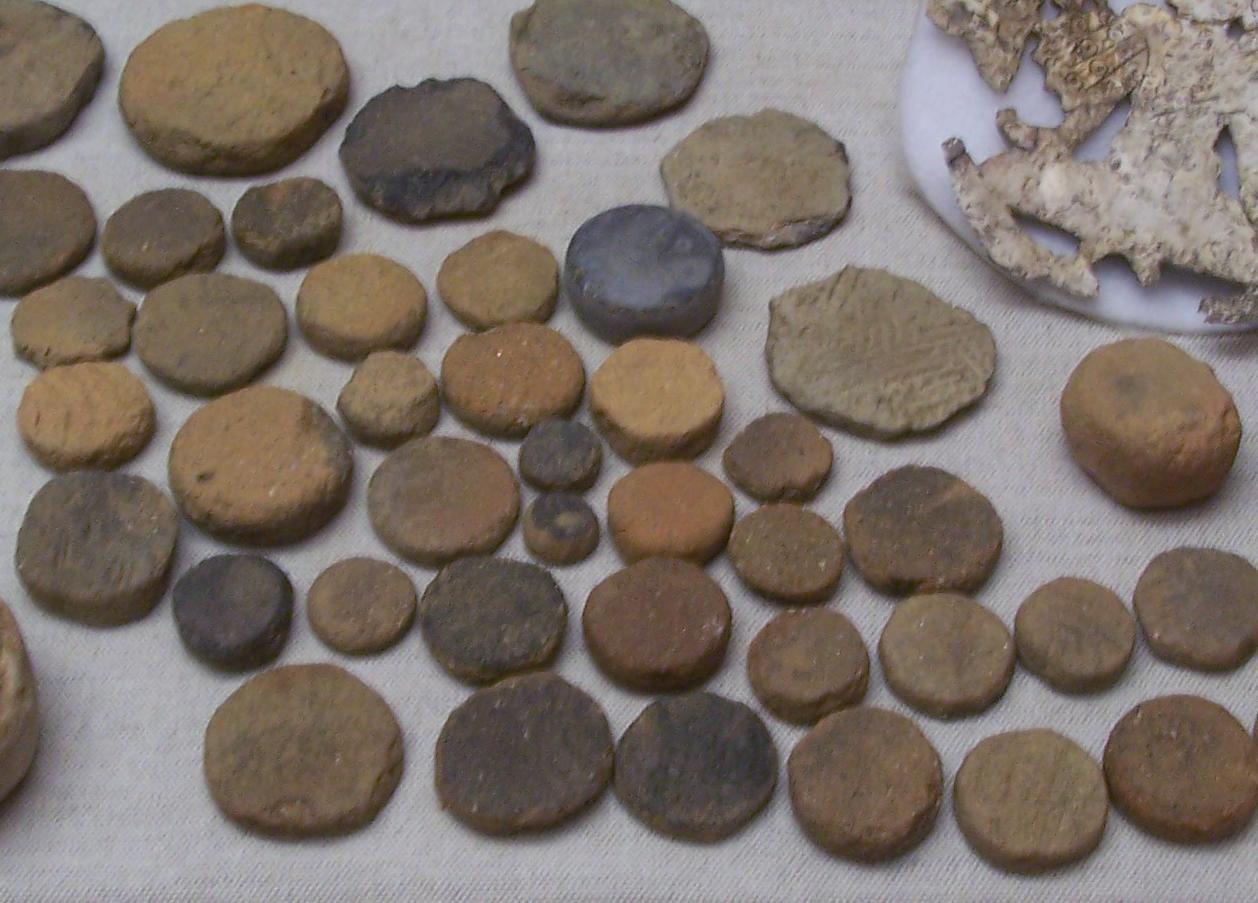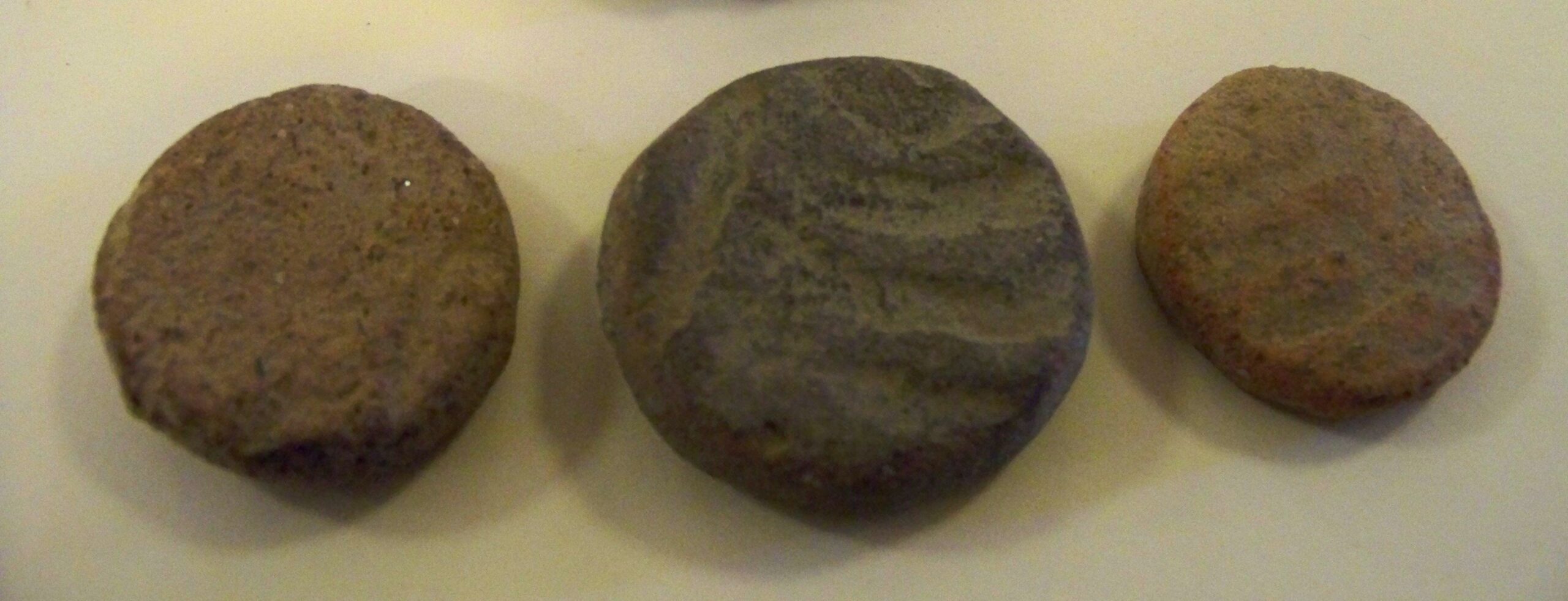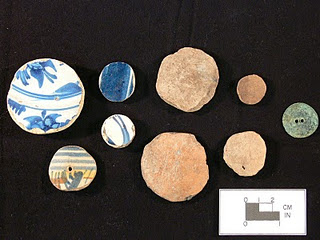Thomas a. Potter, researcher in anthropology at the University of Alabama, wrote the following comments in his abstract regarding his work at the mound of Phil archaeological Park:
“Often overlooked as an ever-present but still insignificant Native American artifact by most archaeological researchers, the ceramic discoidal was manufactured from readily available materials, often from discarded or broken ceramic vessels. The commonplace origin of the discoidal does not reflect its importance in the lives of Native Americans, which is reflected by its almost universal distribution in time and space. Generally regarded by archaeologists as gaming pieces, or counters, discoidals are often grouped with sherds without consideration that they were continually manufactured for specific purposes by Native Americans. While the function of the discoidal is elusive, this research attempts to determine regularity of form by assessing the physical properties of a sample of discoidal, with the expectation that some notion of function will be forthcoming. The primary site chosen for this study was Moundsville (1 TU 500), the second largest Mississippian site in North America. I also compared the findings from Moundsville with those from collections from several other sites in the Southeast. Classifying ceramic discoidals by comparing their physical properties helps us understand how discoidals were utilized and valued by Native Americans.”

The study of discoidal is anchored in the Mississippian culture that flourished from 900 to 1400 A.D. The core area of the Mississippians influence was in the Central Midwest along the Mississippi River floodplain, extending from Cahokia, Illinois to Moundsville, Alabama. However the Mississippian primary influence spread from North Dakota to the tip of Florida and from Western Pennsylvania to Texas.
Because of the importance of stone discoidals as a game piece, some scholars have associated all discoidals with gaming. Because Native American women also played games of chance, pottery discoidal are considered by some scholars to be game pieces or dice that were utilized by females (DeBoer 1993). Designating ceramic discoidals as game pieces may have resulted in their demise as an artifact; often they are not mentioned in site reports.
These ceramic discoidals are from Baldwin County, Georgia. The disc on the left is approximately 2 inches in diameter; the disc on the right measures approximately 3 inches in diameter. These examples are cut from a decorated vessel and are nicely rounded, but not rounded to the extend that those elite discs from Etowah were.
One of the most complete directories of Native American games was written by Stuart Cluin (1907). Cluin listed a number of different examples of game pieces used historically, including walnut shells peach and plum stones, grains of corn, bone, shell, and pottery discoidals. All of the examples shown in his drawings of dice represent sets of dice that are uniform in size.
Ceramic discoidal classification
Mr. Potter began his classification system, first by separating them according to the treatment of the edges, with category one being equivalent to rough-edged discs . This means the edges were chipped and then left in a jagged state. Category two, on the other hand, refers to smooth-edged, the result of grinding or sanding the edges of the shared. His chart then steps down to (a) perforated or (b) solid and (one) that it was manufactured from a shared. The formed category is not shown in his chart because discoidals that were manufactured from raw Clay material had only smooth edges.
The next level distinguishes between (A) decorated and (B) plane discoidal. Decoration is divided into two additional categories, depending upon whether the decorations were either (one) pre–fired, that is, applied to the original vessel before it was formed into a discoidal, or (two) post-fired, that is, applied after the discoidal was formed. If the decoration is post-fired, the chart steps down to six designations referring to designs, I. E., (A) cross, (B) star, (c) indent (indentation in one side), (D) by-indent (indented on both sides), (E) circle, and (f) square. If the discoidal had to decorations, each could be listed, for example, 2AC indicates that the discoidal was post-decorated with a cross and is indented on one side.
Ceramic discoidals were made from discarded or broken pottery. These discoidals began to appear in Late Woodland and Mississippian sites, yet much of the pottery they were made from dated to earlier periods. The perforated example on the left is made from Cartersville Check Stamped pottery that dates to the Middle Woodland period. The example on the right is made from Dunlap Fabric Impressed pottery that dates to the Early Woodland period. It is possible that these earlier pottery types were recovered from borrow pits during mound construction or were surface finds by Native Americans. The examples below are made of Swift Creek Complicated Stamped pottery, also dating to the Middle Woodland period.

The roadway at Moundsville had been excavated by the Civilian Conservation Corps in 1932. In all, 134 units were excavated along the 7240 foot roadway. 130 discoidal were recovered from that area. Grouped by size, the group with the largest sizes contained 8 discoidals measuring from 143 mm to 92 mm. There was a 15 mm brake between this group and the next largest group. This second group consisted of five discoidals measuring from 77 mm to 73 mm. The third group contained 2 discoidal was measuring 66 mm, while the fourth and largest group held 115 discoidals measuring from 63 mm to 26 mm. The fifth and smallest group contained only three discoidal, varying from 22 mm to 21 mm; all three were ground into a smooth-adage discoidal shape. Potter believes the variations in size argue against a uniform design by size, contrary to his initial expectations. It appeared that each pottery discoidal was created for its own purpose and was not patterned after size.
Excavations among elite residential areas of the site yielded a total of 86 pottery discoidals. The largest-diameter discoidal group consisted of seven discoidals measuring from 140 mm to 70 mm. The other group, measuring from 55 mm to 19 mm, contains 79 discoidals. There were no sets or pairs, and the diminishing progression in size reinforces the concept that each discoidal was manufactured as its own entity without regard to any other. Their arbitrary sequence in size thus reinforces the findings from the roadway, that each discoidal was manufactured without a particular template in mind. This condition is contrary to the original hypothesis that assumed the discoidals word game pieces and, therefore, would display uniformity of size and weight as described by Culin. A cache of discoidals was recovered at Moundsville. It was found in a highly elite area on mounds are in 1937. The 11 discoidals in this group were measured and aligned in the same manner as the roadway and mound D discoidal. Once again, the discoidals in this group did not have any common attributes by size. Without a paired set of discoidals to represent the uniformity established by Culin, discoidal size seems idiosyncratic. All of the discoidals in the highly elite location were smooth-adage. There were no rough-adage discoidals on the top of Mount are. The fact that this is a cache suggests that smooth edges were indeed the desired form for the discoidal.

The tin-glazed discoidals from the Susquehannok sites in Lancaster and York counties in Pennsylvania date to the 17th century and demonstrate the continued use of these important discoidals well beyond European contact. The two-hole disc at the far right is not a discoidal at all, but a historic brass whizzer from Fort Hunter in Dauphin County, Pennsylvania. A whizzer is a child’s toy that had a string passed through both holes and tied in a loop. The ends of the loop were held while the disc was would up by swinging it around, then the ends of the loop were pulled, causing the disc to spin and produce a whizzing sound. Perhaps you played with one as a child. Both colonial and Native American children were known to play with whizzers.